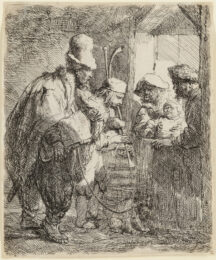

1606-1669
Approximately 300 etchings and drypoints by Rembrandt were produced between 1626 and 1665. His work as a printmaker paralleled his career as a painter; he rarely dealt with the same subjects in both mediums, and he rarely made prints of his paintings. Above all, he was a brilliant experimenter and inventor in this field, frequently using standard materials in unexpected ways. His influence on printmaking is still visible in contemporary etchings.
While still a student in Leiden, Rembrandt started etching early in his artistic career. His early prints frequently include his own face, however they were presumably not intended to be self-portraits but rather studies of various facial expressions.
The Good Samaritan (1633) was one of the larger, highly finished prints Rembrandt attempted to make after relocating from Leiden to Amsterdam, but he quickly abandoned such formal and refined uses of printmaking intended to promote a painter’s work. His prints are frequently small and illegible. He even used the printing plate as a sketch book in Sheet with Two Studies, compiling a variety of seemingly unrelated and incomplete drawings.
In works like Abraham and Isaac, Rembrandt appreciated portraying the realistic human feeling and narrative detail drawn from stories from the Old and New Testaments. Another favoured print topic was scenery. The most profoundly dramatic of these paintings is The Three Trees, in which he portrayed the characteristically windy and wet Dutch weather. He produced landscape prints during the course of his career, first in the 1640s and then again in the 1650s, the latter of which saw the reprinting of many of the earlier group’s prints. Many of his landscapes, like The Windmill (1641) and Clump of Trees with a Vista, give the impression that they were painted outside in the great outdoors, but in reality, he usually composed them in his studio using sketches he made while travelling through the countryside near Amsterdam.
Rembrandt frequently took influence from the work of previous masters including Antonio Tempesta, Lucas van Leyden, and Albrecht Dürer, all of whom he held a sizable collection of prints by. For instance, Jacques Callot’s series of etchings of beggars from 1620 to 1623 served as inspiration for the Beggar Leaning on a Stick, Facing Left and other similar, supposedly naturalistic portraits of people on the street.
Rembrandt started using the printing plate like a canvas in the 1650s, leaving some ink or tone on the plate’s surface to produce “painted” impressions of prints, each of which would have a varied appearance depending on how the plate had been inked. For instance, the etched lines are the only thing that can be seen in The Entombment (1654), which was printed in its original state without plate tone. However, in the second state, he created delicate, moody impressions of the same image by leaving a lot of ink on the printing plate’s surface and then wiping it away in specific places to create highlights, as he did on the body of Christ and some of the figures surrounding him in the impression displayed in the Metropolitan Museum. The “Negress” Lying Down (1658), also known as The Reclining Female Nude, earned its nickname due to the rich, dark tone Rembrandt developed by layering etching and drypoint lines with plate tone. Additionally, he tested out the various outcomes that could be achieved by printing on various papers and other supports. On vellum, a surface that gives the image a warm overall tone and highlights the richness of the ink Rembrandt left on the surface of the plate and the velvety burr generated by his drypoint lines, he printed the impression of the second state of The Three Crosses.
With each state, Rembrandt would drastically alter one of his late prints, essentially reimagining the subject. The viewer of today may in a way bear witness to it because he preserved so many stages of his creative process. Rembrandt decided to produce a totally different version of the picture in a fourth state as the plate of The Three Crosses was deteriorating by removing and polishing huge areas of the foreground and replacing them with fresh drypoint figures and forceful hatching. He changed the scene in the narrative and produced a biblical allegory that was more darker and more dramatic. Additionally, he revised many iterations of Christ Presented to the People, a big print that was totally made using drypoint. The second state, printed on warm-toned japan paper, features a dynamic mix of individuals reacting to the scene in various ways in the foreground. By the eighth state, nothing stands between the direct encounter of Christ and the viewer because he had later deleted the entire group. By the 1650s, Rembrandt had ardent admirers of his prints who had travelled as far south as Italy and had gathered a wide variety of states and impressions of these exceptional works.